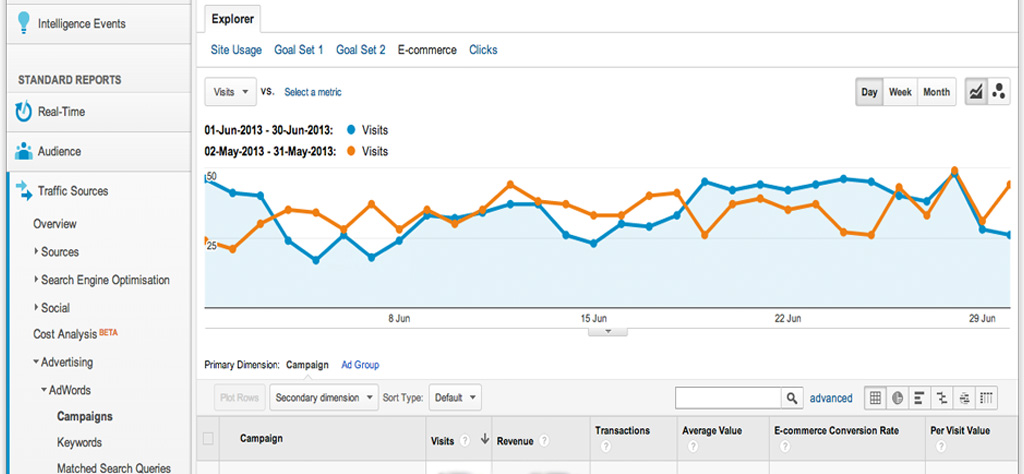Your boss is expecting an AdWords performance report. Not sure what to report on?
Before you get into a black hole of AdWords and Analytics data, first decide what your goals are and what the essential metrics to report on are.
PPC Reporting Structure
PPC Goal Setting
Aimlessness is not the way to go. You'll enjoy the process of reporting a whole lot more if you see it as a competition (against yourself). With your boss, decide on goals, and aim for those.
Goals for PPC can be at Campaign, Ad Group or Account level. If you're focusing on improving performance for a particular campaign, report specifically on that campaign, as well as giving an account level overview.
Examples of goals may be:
- Increase Conversions by 5%
- Increase Conversion Rate by 0.5%
- Increase CTR
- Reduce CPC
Date Range
If you're reporting once a month, use the data from the past month. Likewise, If you report once a week, use the previous weeks data. Compare data from the previous period by selecting the compare dates toggle, and selecting 'previous period'.
Analytics or Adwords?
Use both Adwords and Analytics data for metric reporting. Analytics is especially good for reporting on AdWords sourced 'revenue', 'products purchased', 'average order value', 'time on site', and 'bounce rate'. Both accounts allow export as a PDF, which you can use to put together your report.
Keep it Relevant
Look at the changes you've made and the knock on effects of those changes. For yourself, figure out what works and what doesn't. When reporting to your boss you're likely to focus on the Key PPC Metrics (below).
Think about how your report will be received, and what information the people in the meeting are looking for. It might be worthwhile to ask what metrics are important to certain people in the room, so you can tailor your report to them.
Key PPC Metrics
To get data in AdWords, select the correct date range then click on 'all online campaigns'. You can compare the date range to the previous period (as above).
Managers will generally want to know the following overall account statistics:
1. How many conversions were generated from PPC
Use the Conv (1 Per click) Column in AdWords. If it's an e-commerce site, also report on E-commerce Conversions (Analytics > Conversions > Product Performance with 'Paid Search Traffic' as your advanced segment) and 'Assisted Conversions' (Conversions > E-commerce > Multi-Channel Funnels > Assisted Conversions).
2. How much did those conversions cost?
Note the overall AdWords cost for the set time period. Also check out the Cost/Conv (1 Per Click) Column.
3. How can you reduce the cost of those conversions?
Report on what you did last month and what you plan to do next month. See examples below.
- Review the Search Terms Report for negative keyword opportunities
- Review Landing Pages for Relevancy
- A/B test ad copy
- Filter and review keywords for Low CTR, Low Quality Score, 0r Conversions
4. What is the level of PPC growth?
This can be visualised using the graphs in Google Analytics. Select the date range, and go to Advertising > Campaigns Report, then plot transactions against visits. Be sure to select the E-commerce tab too (if it's an e-commerce site). The comparative date range option allows you to see the change in revenue, transactions and conversion rate.
Your own reporting should expand upon these to include:
1. CTR Changes
2. New Keywords Added
3. KW's that haven't worked - add to Spreadsheet
4. Impression Share
5. Top Vs Other Report
What is a conversion for you?
Be sure of what you define as a conversion. If your company views both registrations and sales as conversions, you'll need to segment this data to give you a better idea of ROI figures.
I recently came across this exact scenario. The client had both registrations and sales set up in Adwords as conversions. In order to segment the data, we set up a URL goal in Analytics for registrations instead, and removed the registration conversion tracking in AdWords.
Split Display, Search & Remarketing
Be sure to report on each medium separately. This means that your search campaign metrics won't get dragged down lower performing brand awareness display campaigns. When you scroll to the bottom of the "all online campaigns" page within Adwords, you'll see the Search/Display split.
Remarketing ads have a higher CTR than an equivalent display ad, and their key metric is view-through conversions. Be sure to report on remarketing separately by clicking on the Display Network tab > Interests & Remarketing tab. Again, scroll to the bottom and pick out Conv (1 per Click) as well as View Through Conv.
Advantages of PPC Metric Reporting
If you can prove your effectiveness at each reporting meeting, you'll quickly prove your own worth. Appropriate reporting makes it easier to manage expectation and offer solutions.
Summary & Actionable Recommendations
While high level reports are often just what your boss is looking for, you should always have more detailed reports for yourself, reviewing the performance from all angles.
Be aware of changes that affect the company, as well as changes within AdWords and Analytics. Use those insights to set your reports in context. As new features come out in AdWords and Analytics (regularly!) have a play, maybe it can further improve your reporting.
What do you include in your reporting?

